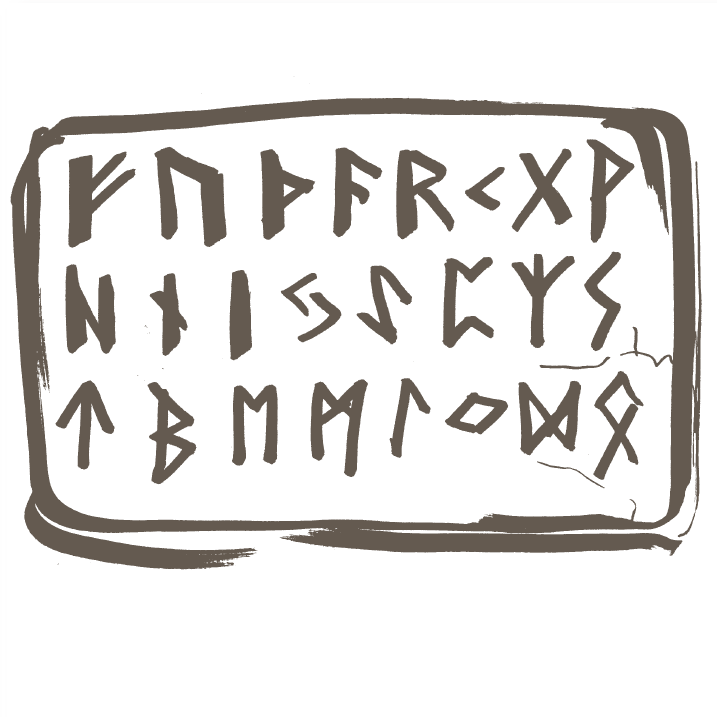Gothic is an extinct Germanic language spoken by the Goths, the earliest known Germanic language.
Language
Gothic is an extinct Germanic language spoken by the Goths, who migrated from southern Scandinavia to eastern Europe. It is classified as one of the East Germanic languages, the only one with extensive written records, which precede written records of other Germanic languages by about four centuries. We can track Gothic in its literary form from the 4th century CE. In an altered structure of Crimean Gothic, the language survived, mainly in spoken form, until the mid-17th century.
Gothic can be divided into two dialects: Ostrogothic and Visigothic, named according to the tribes that spoke the dialects. Ostrogothic occurred in eastern Europe and later Italy, while Visigothic was spoken in east central Europe, along the lower Danube, and later even Spain (presumably due to migration).
The main difference between Gothic and other Germanic languages is the umlaut or the lack of it. Another specific of Gothic is the use of the dual number. Even though Gothic uses singular and plural, to express that there are two (of anything), it diverts from plural and uses exclusively the dual number.
Another characteristic that separates Gothic from other Germanic languages is that it does not seem to exhibit signs of rhotacism (or rhotacization). Rhotacism is a sound change that converts one consonant (alveolar consonant), such as the Proto-Germanic *z, to a rhotic consonant (R-like sounds), r.
The Lord's Prayer in Gothic
-
- Atta unsar, þu in himinam,
- weihnai namo þein,
- qimai þiudinassus þeins,
- wairþai wilja þeins,
- swe in himina jah ana airþai.
- Hlaif unsarana þana sinteinan gif uns himma daga,
- jah aflet uns þatei skulans sijaima,
- swaswe jah weis afletam þaim skulam unsaraim,
- jah ni briggais uns in fraistubnjai,
- ak lausei uns af þamma ubilin.
- Amen.
Script
Originally Gothic was written in the runic alphabet (also called futhark) but very little of it survives. In the late 4th century, bishop Ulfilas (or Wulfila) created a new alphabet with 27 symbols for the Goths, basing it on the Greek alphabet and using a few symbols from the Latin (5-6 modified symbols) and runic alphabet (about 2 symbols) as well.2 There are no separate numerals as each letter is assigned a numeric value as well. For example: 𐌰 “ahsa” (sound: /a/aː/) is assigned the numeric value of 1, whereas 𐍉 “othal” (sound: /oː/) is equal to 800.
Similar to Greek, Gothic uses the double consonant “gg” to write the sound “ng” (in Modern English “ng” as in “thing”) but in some cases gg remains the double consonant. This happens when it precedes 𐍅 “winja” (sound: /w/). This resonates in a general sound development which is referred to as “sharpening” and is a feature shared with Old Norse.
Literature
One of the oldest and longest examples of the Gothic language is the “Codex Argenteus” (or “the Silver book”). The name comes from the silver binding and the ink used in the book: the majority of the text inscribed on the high-quality thin purple vellum is silver with the rest being drawn on in gold ink. The “Codex Argenteus” is a translation of the Bible from Greek to Gothic made by bishop Ulfilas (c. 311CE – 382 CE) around the second half of the 4th century (before 381 CE). It contained both the Old and New Testaments. Only a larger part of the latter survived until today. It is said that the translation of the bible by Ulfilas was made to be as close to the Greek original with one exception: The Book of Kings has been excluded (deliberately), as stated by some sources. The reason is that the mention of war or battle could influence the Goths negatively and rile them up. But this “deliberate exclusion” could as well be due to the loss of certain parts of the “Codex Argenteus”. On the other hand, it is true that from the known examples of the Gothic language, it does lack the vocabulary for war, battle, and political terms.
The “Codex Argenteus” had originally 336 pages of which 187 have been preserved. The codex was first discovered in the 16th century in the Werden abbey. From there it was acquired by the Habsburg emperor, Rudolf II, who took it to Prague to have in his extensive collection. When Prague Castle fell to the Swedes in 1648, the codex was transferred to Stockholm. It then went to Holland and back to Sweden, where it was gifted to the library of the University of Uppsala in 1669, where it remains. Essential for the study of Gothic, the “Codex Argenteus” is the most extensive literary example of the language.
Other literary examples of Gothic language are the “Codex Gissensis” (found in Egypt in 1907, contained four pages with verses from Luke 23-24, in both Gothic and Latin, ruined by water damage), “Codex Carolinus” (palimpsest of four leaves with verses from the Epistle to the Romans both in Gothic and Latin),” Codices Ambrosiani” (five codices, all palimpsests containing verses from the Epistles, Corinthians, Matthew and the book of Nehemiah).
Unlike their biblical counterparts, the other surviving texts are much sparser: notes in a Veronese manuscript, bits of a calendar of martyrs, a Latin deed title written around 551CE in Ravenna7 and a few others.
We have two documented authors that are key to understanding the language and its evolution. The first one is the aforementioned bishop Ulfilas, creator of the Gothic alphabet and “Codex Argenteus” a Christian missionary of Cappadocian origin who evangelized the Goths in the 4th century. The other is Augier Ghislain de Busbecq (1522-1592), a Flemish diplomat and author of a letter from circa 1555-1562 (printed in Paris in 1589) where we can find the most recent traces of the Gothic language. In this letter, he describes his encounter in Crimea with two envoys who spoke a language, presumably Crimean Gothic. However, the letter contains only about a hundred Gothic words.
Influence
Today, we can still find traces of Gothic language influence in some Romance languages. For example, in Portuguese the word “ganso” (goose in Engl.) comes from the Gothic “𐌲𐌰𐌽𐍃 ” (gans), and the word “trégua” (truce in Engl.) has its roots in the Gothic “𐍄𐍂𐌹𐌲𐌲𐍅𐌰 ” (triggwa; meaning treaty or covenant). French has some words of Gothic origin as well, such as “broder” (to embroider in Engl.) which comes from the Gothic “𐌱𐍂𐌿𐌶𐌳𐍉𐌽 ” (bruzdon).
Even though Gothic is an extinct language, it has been used as a creative language by linguists, most notably J.R.R. Tolkien (1882–1973), author of “The Hobbit” and “The Lord of the Rings.” He used Gothic to write a poem called “Bagmē Blōma” (“Flower of the Trees” in English) which was included in a collection created together with E.V. Gordon (1896-1938), called “Songs for the Philologists” (privately printed, University College, London, 1936). Gothic also served as the primary inspiration for one of Tolkien’s invented languages: Taliska (used in “Lord of the Rings”, 1954).







